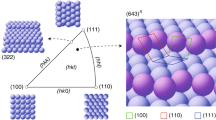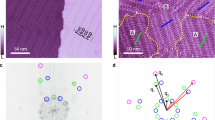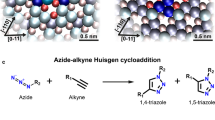Abstract
The increasing demand of the chemical and pharmaceutical industries for enantiomerically pure compounds has spurred the development of a range of so-called ‘chiral technologies’ (ref. 1), which aim to exert the ultimate control over a chemical reaction by directing its enantioselectivity2. Heterogeneous enantioselective catalysis3,4,5 is particularly attractive because it allows the production and ready separation of large quantities of chiral product while using only small quantities of catalyst. Heterogeneous enantioselectivity is usually induced by adsorbing chiral molecules onto catalytically active surfaces1,3,4,5,6,7. A mimic of one such catalyst is formed by adsorbing (R,R)-tartaric acid molecules on Cu(110) surfaces: this generates a variety of surface phases, of which only one is potentially catalytically active8, and leaves the question of how adsorbed chiral molecules give rise to enantioselectivity. Here we show that the active phase consists of extended supramolecular assemblies of adsorbed (R,R)-tartaric acid, which destroy existing symmetry elements of the underlying metal and directly bestow chirality to the modified surface. The adsorbed assemblies create chiral ‘channels’ exposing bare metal atoms, and it is these chiral spaces that we believe to be responsible for imparting enantioselectivity, by forcing the orientation of reactant molecules docking onto catalytically active metal sites. Our findings demonstrate that it is possible to sustain a single chiral domain across an extended surface—provided that reflection domains of opposite handedness are removed by a rigid and chiral local adsorption geometry, and that inequivalent rotation domains are removed by successful matching of the rotational symmetry of the adsorbed molecule with that of the underlying metal surface.
This is a preview of subscription content, access via your institution
Access options
Subscribe to this journal
Receive 51 print issues and online access
$199.00 per year
only $3.90 per issue
Buy this article
- Purchase on Springer Link
- Instant access to full article PDF
Prices may be subject to local taxes which are calculated during checkout



Similar content being viewed by others
References
Sheldon, R. A. Chirotechnology (Marcel Dekker, New York, 1993).
Brown, J. M. & Davies, S. G. Chemical asymmetric synthesis. Nature 342, 631–636 (1989).
Baiker, A. & Blaser, H. U. in Handbook of Heterogeneous Catalysis Vol. 5 (eds Ertl, G. H., Knoezinger, H. & Weinheim, J.) 2422–2430 (VCH, New York, 1997).
Blaser, H. U. Enantioselective synthesis using chiral heterogeneous catalysts. Tetrahedron: Asymmetry 2, 843–866 (1991).
Wan, T. A. & Davies, M. E. Design and synthesis of a heterogeneous asymmetric catalyst. Nature 370, 449–450 (1994).
Tai, A. & Harada, T. in Tailored Metal Catalysts (ed. Iwasawa, Y.) 265–324 (Reidel, Dordrecht, 1986).
Izumi, Y. Modified Raney nickel catalyst: Hetrogeneous enantio-differentiating catalyst. Adv. Catal. 32, 215–270 (1983).
Ortega Lorenzo, M., Haq, S., Murray, P., Raval, R. & Baddeley, C. J. Creating chiral surfaces for heterogeneous catalysis: R,R-tartaric acid on Cu(110). J. Phys. Chem. 103, 10661–10669 (1999).
Woodruff, D. P. et al. The structure of the formate species on copper surfaces: new photoelectron diffraction and SEXAF data reassessed. Surf. Sci. 201, 228–244 (1988).
Lehn, J.-M. Supramolecular Chemistry, Concepts and Perspectives (VCH, New York, 1995).
Riviera, J. M., Martin, T. & Rebek, J. Jr Chiral spaces: dissymmetric capsules through self-assembly. Science 279, 1021–1023 (1998).
Prins, L. J. et al. Complete asymmetric induction of supramolecular chirality in a hydrogen-bonded assembly. Nature 398, 498–501 (1999).
MacGillivray, L. R. & Atwood, J. L. A chiral spherical molecular assembly held together by 60 hydrogen bonds. Nature 389, 469–472 (1997).
Lopinski, G. P., Moffatt, D. J., Wayner, D. D. M. & Wolkow, R. A. Determination of the absolute chirality of individual adsorbed molecules using the scanning tunnelling microscope. Nature 392, 909–911 (1998).
Viswanathan, R., Zasadzinski, J. A. & Schwartz, D. K. Spontaneous chiral symmetry breaking by achiral molecules in a Langmuir-Blodgett film. Nature 368, 440–443 (1994).
International Tables for X-Ray Crystallography Vol. 1 (eds Henry, N. F. M. & Lonsdale, K.) (Kynoch, Birmingham, 1965).
Richardson, N. V. & Sheppard, N. in Vibrational Spectroscopy of Molecules on Surfaces (eds Yates, J. T. Jr & Madey, T. E.) 1–48 (Plenum, New York, 1987).
Woodruff, D. P & Delchar, T. A. Modern Techniques of Surface Science (Cambridge University Press, Cambridge, 1986).
Acknowledgements
We thank the Leverhulme Centre for Innovative Catalysis for a studentship (M.O.L.), and also thank the EPSRC for equipment grants and a post-doctoral fellowship (C.M.).
Author information
Authors and Affiliations
Corresponding author
Rights and permissions
About this article
Cite this article
Ortega Lorenzo, M., Baddeley, C., Muryn, C. et al. Extended surface chirality from supramolecular assemblies of adsorbed chiral molecules. Nature 404, 376–379 (2000). https://doi.org/10.1038/35006031
Received:
Accepted:
Issue Date:
DOI: https://doi.org/10.1038/35006031
This article is cited by
-
Kinetic control over the chiral-selectivity in the formation of organometallic polymers on a Ag(110) surface
Communications Chemistry (2024)
-
Enzymatic polymerization of enantiomeric L−3,4-dihydroxyphenylalanine into films with enhanced rigidity and stability
Nature Communications (2023)
-
Simultaneous switching of supramolecular chirality and organizational chirality driven by Coulomb expansion
Nano Research (2022)
-
Breakdown of chiral recognition of amino acids in reduced dimensions
Scientific Reports (2020)
-
Homochirality in biomineral suprastructures induced by assembly of single-enantiomer amino acids from a nonracemic mixture
Nature Communications (2019)
Comments
By submitting a comment you agree to abide by our Terms and Community Guidelines. If you find something abusive or that does not comply with our terms or guidelines please flag it as inappropriate.



